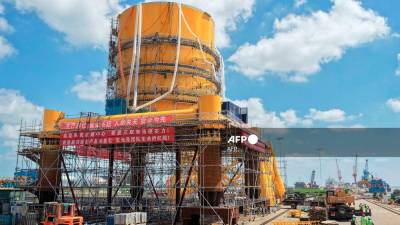NANTONG: A Chinese company is preparing to submerge a server pod in the sea off Shanghai as an innovative solution to the energy demands of data centres.
Workers at a wharf near the city are completing a large yellow capsule that will house servers underwater.
Global reliance on data centres for websites and apps is increasing, with artificial intelligence usage significantly boosting demand.
Underwater operations offer inherent advantages according to Highlander’s Yang Ye, whose firm is developing the Shanghai pod with state-owned construction companies.
Ocean currents naturally cool undersea servers, eliminating the need for energy-intensive air cooling or water evaporation used by land-based centres.
This technology was previously tested by Microsoft off Scotland’s coast in 2018, but the Chinese project represents one of the world’s first commercial services of its kind.
The underwater data centre will serve clients including China Telecom and a state-owned AI computing company as part of government efforts to reduce data centres’ carbon footprint.
Highlander vice president Yang told AFP that underwater facilities can save approximately 90% of energy consumption for cooling.
University of California expert Shaolei Ren said such projects currently focus on demonstrating technological feasibility rather than immediate commercial deployment.
Microsoft never commercialised its trial despite retrieving its pod in 2020 and declaring the project successfully completed.
Ren emphasised that significant construction challenges and environmental concerns must be addressed before mass deployment of underwater data centres becomes feasible.
Chinese government subsidies are supporting these initiatives, with Highlander receiving 40 million yuan for a similar 2022 project in Hainan province that continues operating.
Highlander engineer Zhou Jun acknowledged that actual completion of the underwater data centre involved greater construction challenges than initially expected.
The Shanghai facility is built onshore in separate components before sea installation and will draw nearly all power from nearby offshore wind farms.
Highlander claims more than 95% of the energy used will come from renewable sources.
Protecting servers from moisture and saltwater corrosion presents the most obvious challenge for underwater operations.
The Chinese project addresses corrosion by applying a protective coating containing glass flakes to the steel capsule housing the servers.
An elevator will connect the main pod structure to an above-water segment to allow maintenance crew access.
Ren noted that laying internet connections between offshore data centres and the mainland is more complex than with traditional land servers.
Researchers from the University of Florida and Japan’s University of Electro-Communications found submarine data centres vulnerable to sound wave attacks transmitted through water.
Beyond technical hurdles, the warming effect of underwater data centres on surrounding waters raises ecological concerns.
University of Hull marine ecologist Andrew Want said heat emissions could attract certain species while driving away others.
Want noted these are currently unknowns due to insufficient research being conducted on the ecological impacts.
Highlander cited a 2020 independent assessment of their Zhuhai test project indicating surrounding water remained well below acceptable temperature thresholds.
Ren warned that scaling up data centres would proportionally increase heat emissions into marine environments.
He stressed that thermal pollution problems require more careful study for megawatt-scale underwater data centres.
Ren suggested offshore facilities could complement rather than replace traditional data centres while serving niche market segments. – AFP
